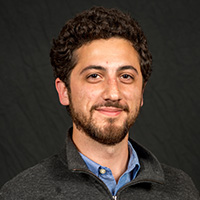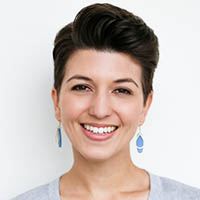By Manuchehr Aminian, Kristin Kurianski, Anna Ma, and Chris Miles
The Southern California Applied Mathematics Symposium (SoCAMS) is a longstanding recurring event that comprises several plenary talks from distinguished speakers and multiple parallel sessions that span various fields of applied mathematics. The informal, one-day conference—which is organized by the Southern California applied mathematics community—aims to provide an opportunity for undergraduate, graduate, and early-career researchers to present their work and share experiences and ideas with colleagues. Originally established in 2001, SoCAMS has since taken place on a fairly regular basis (barring a few interrupted years for circumstances like the COVID-19 pandemic). Incidentally, a log of a mailing list that promotes the first iteration still exists online.
Chris Miles and Anna Ma, both of the University of California, Irvine (UCI), hosted this year’s event, which took place on UCI’s campus on April 22. Over 160 people—including more than 25 poster presenters, 45 oral presenters, and five plenary speakers—attended the day’s festivities. Participants hailed from San Diego, Santa Barbara, Merced, Long Beach, Riverside, and beyond, and the many presentations and posters represented the broad diversity of the university ecosystem in the area; 120 attendees came from R1 schools and another 40 were associated with primarily undergraduate institutions.
Thanks to funding from both SIAM and the NSF-Simons Center for Multiscale Cell Fate Research, the event was free for all attendees and included parking, lunch, and refreshments. Plenary talks by Treena Basu of Occidental College, Franca Hoffman of the California Institute of Technology, Deanna Needell of the University of California, Los Angeles (UCLA), Qing Nie of UCI, and Hayden Schaeffer of UCLA commenced throughout the day. Six parallel contributed sessions took place in both the morning and afternoon with broad themes in optimization and mathematical data science, partial differential equations, mathematical biology, networks, and fluid dynamics. A poster session and luncheon were held during the midday break. The top three posters—determined by popular vote—all received awards, and the winners were honored during the closing remarks. Audrey Oliver of San Diego State University, Isaac Hershenson and Maxine Liu of Harvey Mudd College, and Justin Lee of Claremont Graduate University were this year’s prizewinners.
The five plenary speakers represented a wide variety of research fields. Hoffman opened the meeting by describing her efforts to build algorithms that relate to optimal transport and establish convergence rates, with motivation in Bayesian inverse problems. Next, Schaeffer discussed hybrid methods with dense shallow neural networks that learn differential equations from data. He also shared striking preliminary results that qualitatively match a video of a flocking herd of sheep. After lunch, Needell presented her work in non-negative matrix factorization and explained an approach for debiasing word embeddings in the context of “indirect” forms of bias. Nie then offered a fantastic whirlwind tour of his analyses of various high-throughput data from an applied mathematical perspective. Provocatively (and perhaps as a sign of our times), he was notably less interested in an “ordinary differential equation system” framework for the understanding of microbiological processes and instead favored data-driven descriptions and visualizations of phase space (such as saddles, nodes, and attractor regions).
Just before the event’s conclusion, Basu spoke about her data mining work for Occidental College admissions data—in collaboration with the school’s Department of Admissions and PIC Math (Preparation for Industrial Careers in Mathematical Sciences), which is a program of SIAM and the Mathematical Association of America—with the broad motivation to predict student acceptance of admission offers. She also overviewed her attempts to model and predict “summer melt,” which refers to students who accept admission offers but never actually show up once school begins.
Overall, the 2023 rendition of SoCAMS was a resounding success. This was only the second in-person iteration of the event since the COVID-19 pandemic, and the joy of meeting new peers and reconnecting with old friends was palpable. As is tradition, a new set of co-organizers was recruited during the conference and the cycle begins anew. We look forward to gathering for SoCAMS 2024 at the University of California, San Diego!

|
Manuchehr Aminian is an assistant professor in the Department of Mathematics and Statistics at California State Polytechnic University, Pomona. His research interests include mathematical modeling, visualization, and mathematical methods in data science.
|

|
Kristin Kurianski is an assistant professor of mathematics at California State University, Fullerton. Her research interests include mathematical modeling and wave-type phenomena.
|
|
Anna Ma is an assistant professor in the Department of Mathematics at the University of California, Irvine. Her research interests include numerical linear algebra and mathematical data science.
|
|
Chris Miles is an assistant professor of mathematics at the University of California, Irvine. He is interested in the use of modeling and data science to understand stochastic dynamics in biological systems at the cellular and molecular scale.
|